
Acacia dealbata, the silver wattle, blue wattle or mimosa, is a species of flowering plant in the legume family Fabaceae, native to southeastern Australia in New South Wales, Victoria, Tasmania, and the Australian Capital Territory and widely introduced in Mediterranean, warm temperate, and highland tropical landscapes.
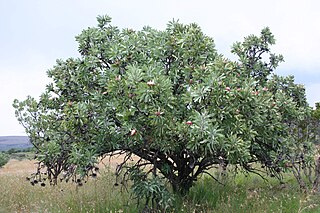
Protea caffra, native to South Africa, is a small tree or shrub which occurs in open or wooded grassland, usually on rocky ridges. Its leaves are leathery and hairless. The flower head is solitary or in clusters of 3 or 4 with the involucral bracts a pale red, pink or cream colour. The fruit is a densely hairy nut. The species is highly variable and has several subspecies.
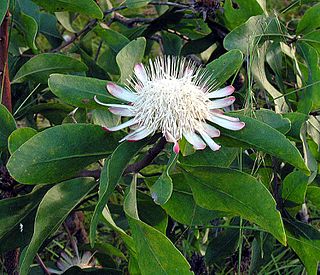
Protea gaguedi is a species of tree which belongs to the genus Protea.
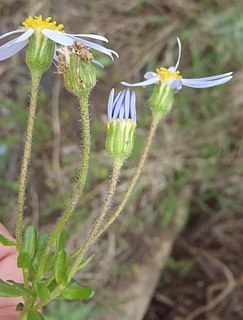
Felicia aethiopica is a low shrublet of up to about 50 cm high that is assigned to the family Asteraceae. It has rigid, leathery, inverted egg-shaped leaves, with only the lowest pair set oppositely. It has flower heads with an involucre of about 8 mm in diameter with bracts that each contain three resin ducts, and have one whorl of twelve to fourteen ray florets with about 11 mm long and 1½ mm wide blue straps surrounding many yellow disc florets. The plant is called wild aster or dwarf Felicia in English, and wilde-aster or bloublombossie in Afrikaans. Flowering occurs year-round. Wild aster can be found in the Western and Eastern Cape provinces of South Africa.

Indigofera australis, the Australian indigo or Austral indigo, is an attractive species of leguminous shrub in the genus Indigofera. The genus name Indigofera is Neo-Latin for "bearing Indigo". Australis, from the Latin, means not “Australian” but "southern", referring to the geographical distribution of the species.

Hypericum revolutum is a shrub or small tree in the genus Hypericum native to Arabia and Africa. It is evergreen, with leaves opposite, closely spaced and crowded at the ends of branches, c. 20 × 5 mm, green to slightly glaucous, sessile, clasping at the base. Single bright yellow flowers form at the ends of branches, up to 5 cm in diameter, blooming from June to November. Fruit is a reddish-brown capsule, up to 13 × 10 mm.

Euclea crispa, commonly known as the blue guarri, is an Afrotropical plant species of the family Ebenaceae. The hardy and evergreen plants may form a dense stand of shrubs, or grow to tree size. It is widespread and common in the interior regions of southern Africa, and occurs northward to the tropics. Though some are present near the South African south and east coasts, they generally occur at middle to high altitudes. It is readily recognizable from its much-branched structure and dull bluish foliage colour. Those bearing lanceolate leaves may however resemble the Wild olive, another common species of the interior plateaus.
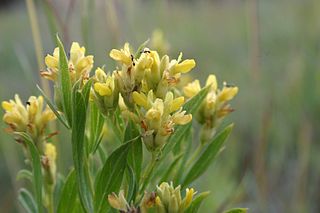
Pearsonia cajanifolia is a South African shrublet belonging to the family of Fabaceae, and one of 13 species in the genus, usually herbs or shrublets with woody rootstocks and all occurring in Africa south of the equator with the exception of 1 species found on Madagascar. P. cajanifolia is commonly found in submontane grassland, at altitudes 1350–2100 m, in the South African provinces of Free State, Gauteng, Limpopo, Mpumalanga, and North West, also in Zimbabwe and Malawi.

Boscia foetida, commonly known as the stink shepherd's tree and the smelly shepherd's bush, is an evergreen shrub or tree that is native to the warmer and drier parts southern Africa. It is found in semi-desert and arid bushveld, and in the west it occurs commonly in areas which are otherwise sparsely wooded. It is known for the particularly unpleasant smell of its flowers which appear during early spring, to which its specific name foetida alludes. Its freshly cut wood likewise has an unpleasant smell, and has traditional medicinal and magical uses, for instance as a protection against lightning.

Serruria fasciflora or common pin spiderhead is a species of flowering plant in the family Proteaceae. It is a sprawling to upright shrublet of 40 cm to 1 m high and about 1⁄2 m wide. It has finely divided, upward curving leaves with thread-thin segments and clusters of sweetly scented heads, each consisting of five to seven silvery pink flowers, that may be found year-round, but mostly from May to December. It is a rather widespread and common species, that is restricted to the south of the Western Cape province of South Africa.

Leucospermum tomentosum is an evergreen, mostly spreading shrublet of approximately 75 cm (3 ft) high and up to 3 m (10 ft) in diameter, with alternately set, linear or narrowly spade-shaped, grey felty leaves, with one to three teeth near the tip. It has round, seated flower heads of 3–3½ cm (1.2–1.4 in) in diameter, occurring in groups of one to four, and consisting of deep yellow, very sweet scented flowers. It can survive the occasional wildfire because it regenerates from the underground rootstock. It is an endemic species that is restricted to a narrow strip along the Atlantic coast of the Western Cape province of South Africa. The species flowers between June and November. It is called Saldanha pincushion in English.

Leucospermum heterophyllum is a low, trailing evergreen shrublet of up to 15 cm (6 in) high, and up to several m in diameter, which is assigned to the family Proteaceae. It has narrow leaves of about 2½ cm (1 in) long and ½ cm (0.2 in) wide, mostly with three teeth near its tip. It has small, globe-shaped, whitish flower heads. It is called trident pincushion in English and rankluisie in Afrikaans. It naturally occurs in the Western Cape province of South Africa. The plant flowers between August and January.
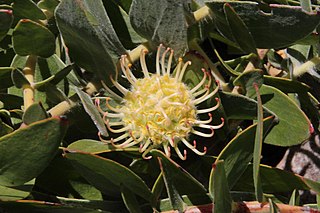
Leucospermum cordatum is an evergreen, creeping shrublet of about 20 cm (8 in) high from the family Proteaceae. It has pale cream flower heads, from which pink flushed styles emerge, the whole reminiscent of a pincushion. Its common name is heart-leaf pincushion in English. It flowers between July and December but the peak of the flowering period is from September to November. It is an endemic species, that is only known from two locations close to each other in the Western Cape province of South Africa.
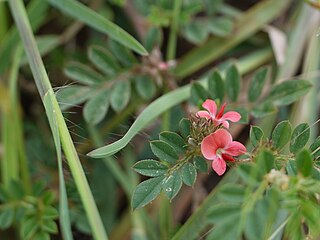
Indigofera linnaei, known as Birdsville indigo and nine-leaved indigo, is a species of leguminous shrub in the genus Indigofera. The genus name, Indigofera, is derived from Latin and means bearing/containing indigo, while linnaei derives from Linnaeus.

Asparagus striatus ("Bergappel") is a hard perennial shrublet of the Asparagus genus, that is indigenous to dry, rocky areas of South Africa.
Struthiola tetralepis is a willowy shrublet of up to 30 cm (0.98 ft) high that is assigned to the family Thymelaeaceae. It has long straight branches that are initially hairy and are covered in leaves pressed against them. These leaves are small, overlapping, lance-shaped, sharply pointed, have a regular row of hairs along the margins, and 3-5 veins are visible on the outward facing surface. It has initially greenish yellow, later reddish brown flowers, each of which consists of a tube of about 1 cm (0.39 in) long with 4 lance-shaped, pointed sepal lobes and 4 yellow alternating petal-like scales. It flowers between October and February. It can be found in the southwest of the Western Cape province of South Africa. It is sometimes called cross capespray in English.

Thunbergia atriplicifolia, the Natal primrose, is a species of flowering plant in the family Acanthaceae, native to South Africa and Eswatini. It is a favored browse of the steenbok.

Hewittia malabarica is a flowering plant in the monotypic genus HewittiaWight & Arn., belonging to the family Convolvulaceae and widespread throughout tropical Africa, Asia, and Polynesia. It is a climbing or prostrate perennial herb with slender stems and flowers that are pale yellow, cream, or white with a purple center, and large leaves that can be used as a cooked vegetable or used in folk medicine with the roots. The stems can be used to make ropes.

Tylecodon wallichii is a species of succulent plant in the genus Tylecodon belonging to the family Crassulaceae. The species is named in honour of Nathaniel Wallich, early 19th century Danish plant hunter, botanist and physician.

Gerbera ambigua is a species of flowering plant in the section Lasiopus of genus Gerbera belonging to the basal Mutisieae tribe within the large Asteraceae family.





















